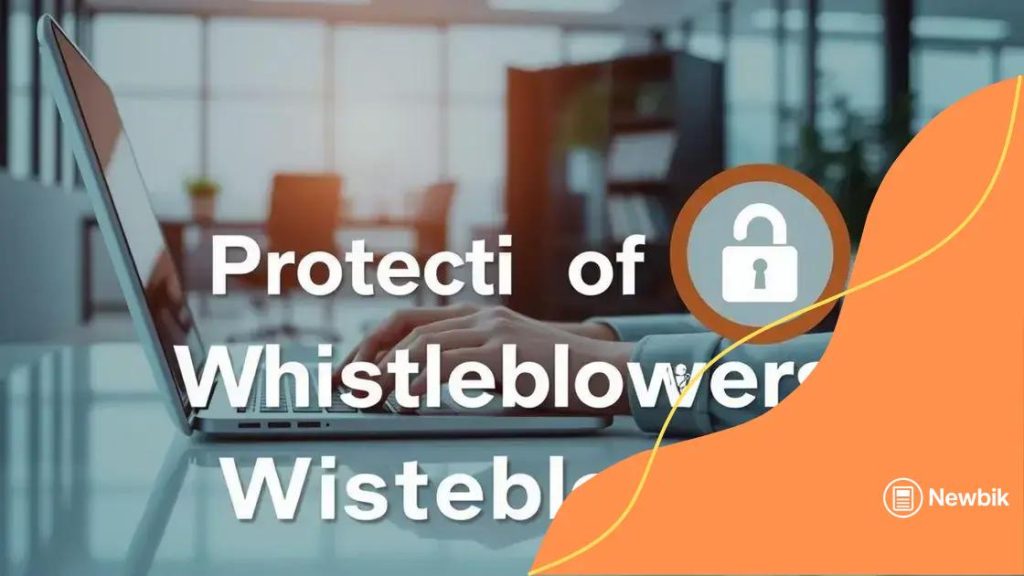Whistleblower anonymity protection: what you need to know

Whistleblower anonymity protection allows individuals to report misconduct safely without revealing their identities, fostering a culture of transparency and accountability while addressing potential retaliation concerns.
Whistleblower anonymity protection plays a crucial role in encouraging individuals to report misconduct. Have you ever wondered how safety in speaking out can change outcomes? In this article, we’ll dive deep into the importance of anonymity for whistleblowers and what it means for accountability.
Understanding whistleblower anonymity protection
Understanding whistleblower anonymity protection is essential in today’s workplace. Many individuals hesitate to report misconduct due to fear of retaliation. By ensuring anonymity, organizations can foster a safer environment where employees feel empowered to speak up.
Key Elements of Anonymity Protection
There are several critical elements involved in protecting a whistleblower’s identity. These measures provide a framework for individuals to feel secure when coming forward.
- Legal protections: Various laws safeguard whistleblowers from retaliation.
- Confidential reporting channels: Organizations should implement secure methods for reporting.
- Training and awareness: Employees must understand their rights and how to report concerns safely.
- Organizational culture: A supportive environment encourages open communication.
Establishing these elements helps create a robust system for protecting whistleblowers. By having legal protections in place, individuals can safely report issues without fearing consequences. Confidential reporting options are vital, as they allow whistleblowers to share information discreetly.
Impact on Reporting
The impact of anonymity protection on reporting practices is significant. When employees know they can report wrongdoing without revealing their identity, they are more likely to do so. This increases the chances of uncovering unethical practices.
Furthermore, organizations that prioritize anonymity often see a boost in employee morale. Individuals feel valued and safe, which fosters a culture of transparency. In such environments, open discussions about ethical concerns can thrive.
Challenges in Implementation
Despite the importance of anonymity protection, there are challenges. Organizations must navigate legal complexities and ensure compliance with various regulations. Additionally, creating an effective anonymous reporting system requires investment in secure technology.
Ultimately, for whistleblower anonymity protection to be effective, ongoing evaluation and adaptation are necessary. Organizations must be willing to respond to new challenges and continuously improve their systems.
By understanding these aspects, both employees and organizations can create a culture that supports transparency and accountability, paving the way for a safer workplace.
Laws and regulations governing anonymity
Laws governing whistleblower anonymity are essential for protecting individuals who report unethical actions. These laws vary by country and can offer different levels of protection, ensuring that whistleblowers can report concerns without fear of retaliation.
Key Whistleblower Protection Laws
Several key laws provide frameworks for protecting whistleblowers. Understanding these can help organizations comply with regulations and encourage employees to come forward.
- The Whistleblower Protection Act (WPA) in the United States shields federal whistleblowers.
- The Dodd-Frank Act protects whistleblowers who report securities violations.
- European Union directives foster similar protections across member states.
- Local laws may also exist that offer additional safeguards.
These laws often include provisions for anonymity, meaning that organizations must implement secure ways to handle reports. This can include anonymous hotlines or secure online platforms where employees can share information without revealing their identities.
The Role of Compliance Programs
A strong compliance program is vital for organizations aiming to adhere to whistleblower protection laws. By establishing these programs, companies can guide employees on how to report issues safely.
Such programs often feature training sessions that outline the protections available to whistleblowers. This ensures employees understand their rights and the processes in place to protect their identities.
Additionally, effective compliance programs help organizations respond to reports swiftly and appropriately. This fosters trust and reinforces a culture of transparency.
The Importance of Legal Guidance
Navigating laws and regulations governing anonymity can be complex. Organizations should seek legal advice to ensure they are fully compliant. Legal counsel can assist in creating policies that align with current regulations.
This proactive approach can help avoid legal pitfalls and ensure that employees feel safe when reporting. In turn, this leads to a more ethical workplace environment.
Impact of anonymity on reporting practices

The impact of anonymity on reporting practices is significant and far-reaching. When individuals know they can report misconduct without revealing their identity, they are more inclined to come forward. This encourages a more open environment where concerns about unethical behavior can be addressed effectively.
Increased Participation in Reporting
Anonymity often leads to higher participation rates in reporting incidents. Employees may feel safer knowing their identities are protected. This is especially true in workplaces where there may be a history of retaliation against whistleblowers.
- Reports of wrongdoing increase as employees feel less fear.
- More individuals are willing to share sensitive information.
- Anonymity creates a sense of security in the workplace.
- A supportive environment encourages collective reporting among employees.
As a result, companies can address issues quickly and often before they escalate. The information provided anonymously can be critical in spotting patterns or serious misconduct that could harm the organization.
Quality of Information
Another important factor is the quality of the information being reported. When individuals feel comfortable and secure, they are likely to provide more detailed accounts of incidents. This level of detail can assist organizations in understanding the full scope of the issues at hand.
Employees who report anonymously often share insights that may not have surfaced otherwise. They may know specific details regarding the misconduct that can lead to effective interventions. Furthermore, this type of reporting helps in pinpointing areas within the organization that require improvement or a change in policy.
Challenges of Anonymity
Despite its advantages, anonymity does come with challenges. Organizations may find it difficult to follow up with anonymous reports to clarify details. Sometimes, lacking direct contact can hinder the investigation process. Additionally, there is a risk of false reports being made anonymously, which can disrupt workplace harmony.
To mitigate these challenges, companies should adopt clear procedures that allow for anonymous reporting while ensuring accountability. Establishing a structured process supports the integrity of the anonymity framework, allowing companies to navigate these challenges effectively.
Real-life examples of successful anonymity protection
Real-life examples of successful anonymity protection illustrate how effective these measures can be in encouraging whistleblowers. These cases reveal the positive outcomes that can occur when individuals feel safe to report wrongdoing.
Case Study: The Enron Scandal
One of the most notable examples involves the Enron scandal. Whistleblower Sherron Watkins raised concerns about accounting irregularities within the company. Thanks to the protections in place, she could report her findings anonymously, ultimately leading to investigations and significant reforms in corporate governance.
Healthcare Sector Success
In the healthcare sector, anonymity protection has helped expose malpractice. Hospitals that implement confidential reporting systems often find that employees alert management to issues like patient safety concerns and unethical practices. For example, a large hospital utilized an anonymous hotline, resulting in numerous reports that led to improved patient care and internal policy changes.
Compliance in Financial Services
Another example comes from the financial services industry. A major bank adopted a comprehensive whistleblower program that included anonymity assurances. This encouraged employees to report unethical behavior related to loans and lending practices without fear. As a result, the bank was able to address potential violations proactively and improve its internal controls.
- Empowering employees leads to early detection of issues.
- Anonymity fosters a culture of trust within organizations.
- These cases underscore the need for strong whistleblower protections.
- Success in these scenarios boosts employee morale and commitment.
These real-life success stories highlight the effectiveness of anonymity protection in various sectors. By prioritizing the safety of whistleblowers, organizations can uncover critical issues while fostering a culture of transparency and integrity.
Challenges in enforcing anonymity protections
Enforcing anonymity protections poses several challenges for organizations. While laws and regulations lay the groundwork, translating these into effective practices can be complex. Understanding these challenges is crucial to developing robust systems that protect whistleblowers.
Identifying and Addressing Abuse
One major challenge is the potential for abuse of anonymity provisions. Some individuals may make false or misleading reports without accountability. This can lead to unnecessary investigations and can divert resources from genuine complaints.
- Establishing clear guidelines can help filter out frivolous reports.
- Organizations need to implement checks to verify the validity of claims.
- Promoting a culture of responsibility in reporting can mitigate misuse.
- Balancing anonymity with accountability is essential.
Organizations must design reporting systems that are both secure and responsible. By creating structured processes, they can encourage genuine whistleblowing while protecting the integrity of the system.
Communication Gaps
Another challenge in reinforcing anonymity protections is overcoming communication gaps between employees and management. If employees are unaware of how to report concerns anonymously, they may hesitate to speak up. Furthermore, a lack of trust in the management can discourage transparency.
Building trust within the organization is vital. Training sessions can educate employees about their rights and the reporting process. Additionally, leadership must show they take whistleblower reports seriously, responding promptly and appropriately to concerns.
Legal and Compliance Issues
Legal complexities can also hinder the effective enforcement of anonymity protections. Organizations must stay updated on relevant laws and regulations, which can vary by region and industry. Failure to comply with these regulations can lead to legal ramifications and damage to the organization’s reputation.
To navigate these waters, companies should seek ongoing legal counsel. A thorough understanding of regulations ensures compliance and promotes a safe reporting environment.
FAQ – Frequently Asked Questions about Whistleblower Anonymity Protection
What is whistleblower anonymity protection?
Whistleblower anonymity protection ensures that individuals can report wrongdoing without revealing their identity, thus reducing the fear of retaliation.
Why is anonymity important in the reporting process?
Anonymity is crucial because it encourages more employees to come forward with information about misconduct, leading to a more transparent workplace.
What are some challenges in enforcing anonymity protections?
Challenges include potential abuse of anonymity provisions, communication gaps between employees and management, and legal complexities.
How can organizations improve their whistleblower protection systems?
Companies can improve their systems by implementing clear reporting procedures, providing regular training, and fostering an organizational culture of trust.